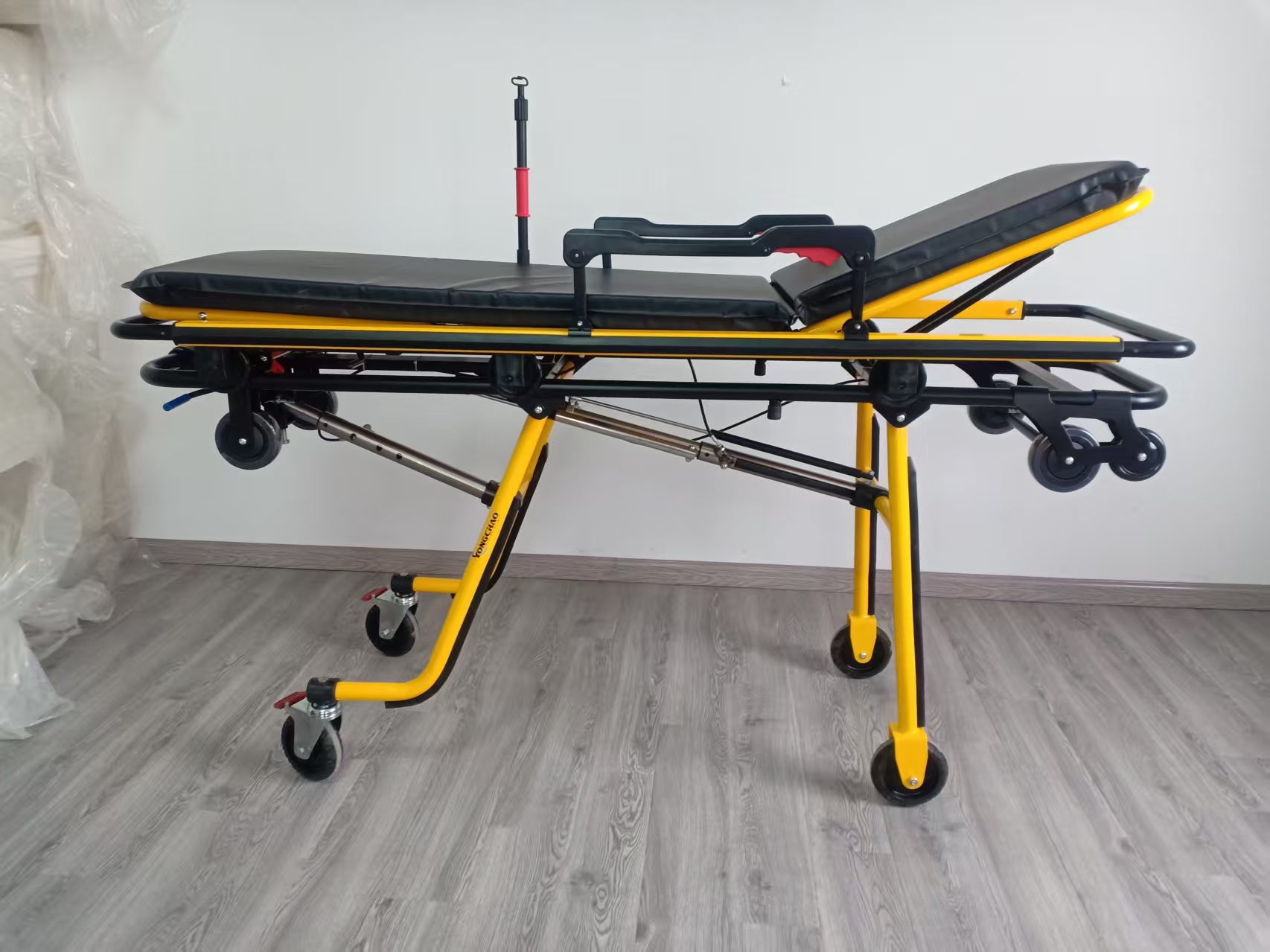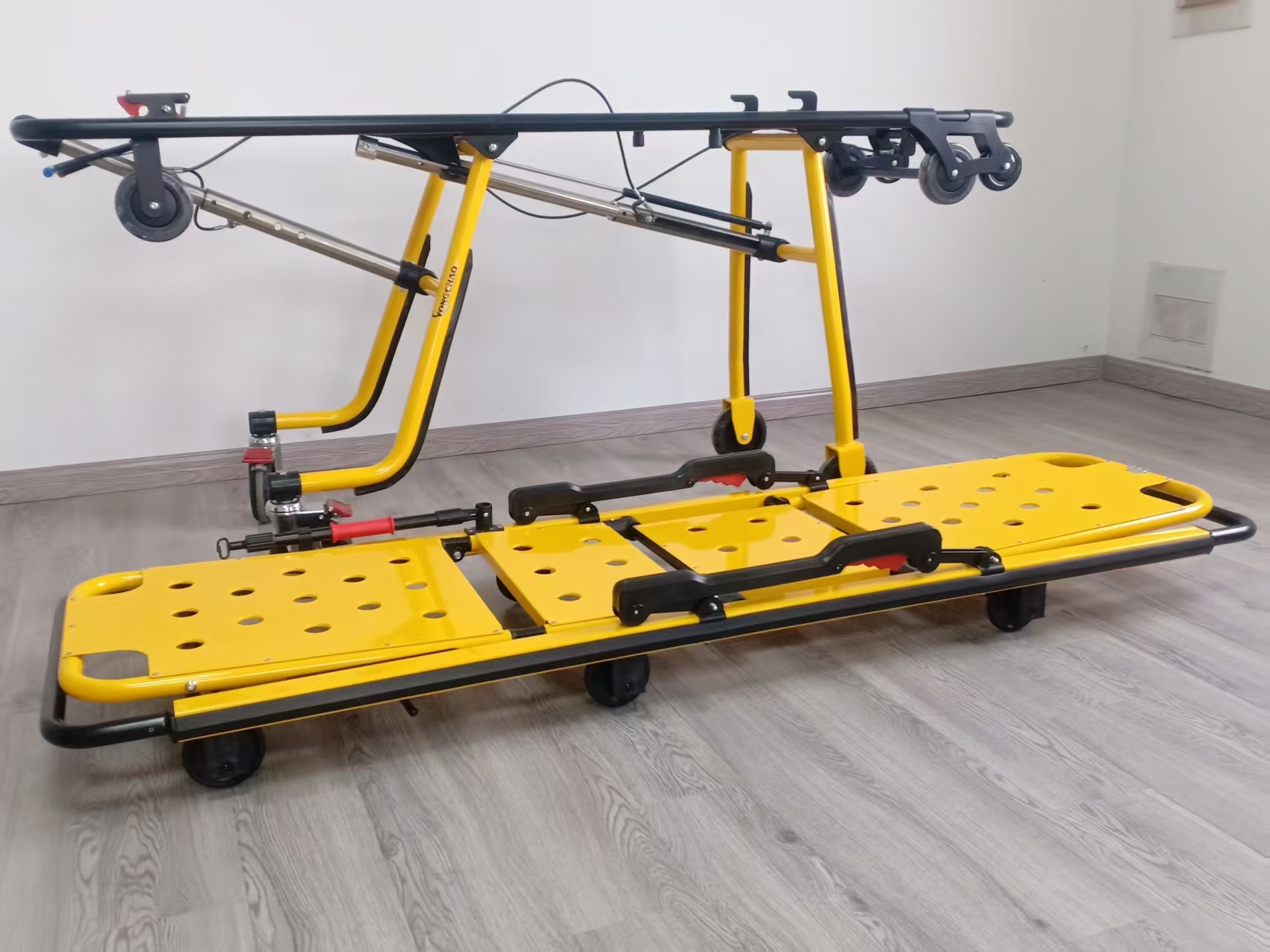Overview of Ambulance Bed
The ambulance bed is also called an ambulance stretcher. It plays a key role in emergency medical services. We design it to transport patients in a safe way. This matters most during critical situations. Key features include:
Safety mechanisms to secure patients during transport
Height and angle adjustability to meet different medical and transport needs
Portability and lightweight design, making it easy for emergency responders to carry
Quick deployment systems that help responders handle patients in urgent situations

I believe ambulance beds do more than carry patients. They are advanced tools built to give patients safe and comfortable transfers. Based on my experience, these beds make a real difference for people who need urgent medical care. They help responders move patients with ease and care.
Key Features and Functions of Ambulance Beds
Ambulance beds solve urgent needs in emergency medical transport. I believe their smart design keeps patients safe. It also helps responders work more easily.
High Weight Capacity
Standard ambulance beds support weights up to 700 lb (318 kg).
Bariatric models work for patients over 300 lb (136 kg). These models have reinforced frames. They include extended safety restraints. This provides reliable support for heavier patients.
Advanced Adjustability & Positioning
Beds have adjustable load heights with up to three settings. This fits different ambulance entry levels.
Adjustable backrests (pneumatic or gas-assisted) help position patients comfortably.
Optional knee gatch features boost patient comfort. They make medical work easier.
The bed converts quickly between flat and shock positions. This adapts to urgent patient care needs.
Enhanced Mobility & Maneuverability
Lightweight aluminum frames make maneuvering easy. This works even in tight ambulance spaces.
Large handles and built-in pull handles give responders precise control.
The wheels work well on rough terrain. This ensures smooth patient pick-up from tough locations.

Comprehensive Safety Systems
Advanced locking mechanisms fasten the bed inside the ambulance. This prevents unwanted movement during transit.
Beds include multiple safety straps and side rails (up to 38% wider for larger patients). They also have retractable head sections for maximum protection.
Many ambulance beds meet SAE J3027 dynamic crash safety standards. Based on my experience, this provides proven security in high-impact situations.
Power-Assisted Operational Features
Hydraulic or electric lift mechanisms reduce physical strain on responders. They decrease back and spinal injuries.
Battery-powered hydraulic systems raise or lower the bed automatically. This speeds up patient loading and unloading.
Transformable and Flexible Modes
Many models offer up to seven locking height positions. They have foldable legs for quick response.
I recommend beds that can be set up for different patient needs. This ranges from pediatric cases to bariatric care. Safety and efficiency stay strong.
Superior Padding and Frame Design
Thick padding absorbs shock. It protects patients during movement.
Narrow frame designs create more working space. Rescue staff can work better alongside the patient.
The structural features boost comfort, stability, and safety. This continues through the entire emergency transport.
Advanced Technologies in Modern Ambulance Beds
I’ve watched ambulance bed technology change a lot in 2025. The focus now is on automation, smart systems, and real-time data. These changes make patient care better. Emergency medical services work faster too.
Smart and Electric Ambulance Beds
Automated adjustments let you change patient position quickly. They need little manual work.
Mobility assist tools and safety features work together. They keep patients comfortable and secure during transfer.
Grace Medy’s 2025 models use environmentally friendly materials. They have one-button CPR. I like this because it saves time in emergencies.
AI-Powered Bed Management & Diagnostics
Artificial intelligence handles scheduling and transfer routes. It also monitors patients. This cuts delays and uses resources better.
Emergency staff get real-time diagnostic data. They see current patient health status. This helps them make better clinical choices.
Automated Height and Tilt Mechanisms
Motorized systems adjust height and tilt on their own. This makes patient loading easier. Unloading is faster. Clinical procedures during transit go smoother.
I suggest these features for safer transfers. Medical staff can access patients more easily.
Summary List of Key Advanced Technology Features
Smart sensors for vital signs, pressure, and movement
Automated height and tilt adjustment
Alarm notifications for urgent clinical events
Dual control panels for both patient and caregiver use
These technologies shape the ambulance bed market in 2025. They bring better efficiency. They create safer conditions. Patients get superior comfort. Emergency medical teams and patients both benefit from faster clinical response.
Usage Scenarios of Ambulance Beds
Ambulance beds are essential in emergency medical services. They handle fast response and safe transport during critical situations. I’ve seen them play a key role in high-pressure settings. Time and safety matter most in these cases.
Common Emergency Deployment Cases
Traffic Accidents
Ambulance beds help transfer trauma patients. These patients often have fractures, head injuries, or other serious conditions. Fast immobilization matters during patient movement. We need to stabilize them from the accident scene to the emergency room.
Natural Disasters
Disaster zones include earthquakes, floods, or fires. Ambulance beds help first responders evacuate and move casualties. They work even when the terrain is unstable or full of debris. The beds keep patients safe and secure.
Sudden Medical Emergencies
Heart attacks and strokes need immediate response. Ambulance beds provide a stable platform for care. They ensure safe transport to medical facilities. I recommend beds that adjust fast for lifesaving interventions during transport.
Rescue Operations
Search-and-rescue efforts use adapted ambulance beds. Portable stretchers work for confined-space rescues. Their design supports safe extraction. They navigate through tight or vertical spaces. The patient stays protected the entire time.
Importance of Fast and Safe Patient Transport
Ambulance beds deliver care from the first point of contact. Patients receive continuous support as we move them from high-risk locations to hospital care. Based on my experience, using these beds increases survival rates. They minimize treatment delays.
Flexibility Across Emergency Settings
Urban traffic, rural disaster zones, or remote rescue sites all need different approaches. The adaptability and safety features of ambulance beds make a real difference in patient outcomes. Fast deployment and adjustability provide lifesaving support. Every second matters in these moments.
Selection Criteria for Choosing the Best Ambulance Bed
I recommend you check three main things when picking an ambulance bed: safety standards, material quality, and where you’ll use it. The right bed keeps patients safe and helps responders work faster in emergencies.
Key Ambulance Bed Selection Checklist
Certification and Compliance
Make sure the bed has ISO and CE standards for ambulance equipment.
This certification means the stretcher is safe for moving patients. It also fits most ambulance interiors.
Weight Capacity
Most ambulance beds hold 159–204 kg (350–450 lb).
Need one for bariatric or heavy-duty use? Check the real maximum weight it can handle. Don’t forget to add the weight of medical gear you’ll attach.
Adjustability
I suggest models with multi-level height settings. Variable backrest angles are important too.
Beds that adjust make patients more comfortable. They also give you more care options during transport.
Mobility and Maneuverability
Check the wheel quality. Large, medical-grade wheels with good bearings move smoother.
A quick locking system keeps things safe. This matters during loading, unloading, and sudden stops.
Patient Safety Features
Look for strong safety straps. You need adjustable side rails and locks that work well.
Wide rails protect patients better. Multi-point harnesses help during rough transfers.
Material and Frame Quality
Pick aluminum alloy frames. They’re strong but light.
Get mattress covers that clean easily. Antimicrobial ones meet hygiene rules and are simple to maintain.
Operational Environment Suitability
Match the bed to where you work. City ambulances need compact beds that move easily. Rural and off-road areas need heavy-duty beds with more stability and space.
Essential Considerations
Certified safety is a must for compliance and insurance.
Materials should be light but strong. This boosts efficiency and makes the bed last longer.
Beds that move easily save time. They also help responders stay less tired.
Pick a bed that fits your service area. Urban emergencies are different from rural rescues.
Based on my experience, a great ambulance bed combines smart safety design, strong patient support, and flexibility. Every feature matters in fast, high-pressure medical care.
This is an operation video of an ambulance bed produced by Grace Medy. It meets all the conditions mentioned above and you can refer to it.
Future Trends in Ambulance Bed Technology and Design
Ambulance beds are shifting toward smarter, more connected, and safer solutions. I see rising demand for emergency transport tools that handle modern medical workflows and improve patient outcomes. Below are the key future trends I recommend watching in ambulance bed development.
Integration with Digital Health Systems and Smart Connectivity
IoT Connectivity: Future ambulance beds will sync with hospital electronic health records (EHR) and EMS telemedicine platforms. Vital patient data—such as heart rate, blood pressure, and bed position—will transmit from the bed to care providers in real-time. I believe this connection will transform emergency care.
RFID and Digital Tracking: Real-time tracking of both patient and equipment location streamlines resource scheduling. It speeds up patient handoff. This makes the entire emergency system more efficient.
One-touch Integration: Beds will feature simple interfaces for paramedics and hospital staff. Features like “one-button report handoff” or “automatic patient status upload” will cut down on paperwork. They reduce manual data entry too.
Growth of AI-Driven Emergency Workflows and Automation
Automated Bed Positioning: AI-powered beds can adjust height, tilt, and support modes based on patient condition. This boosts safety. It speeds up urgent interventions.
Predictive Diagnostics: AI algorithms monitor critical indicators. They alert paramedics to sudden changes. Based on my experience, I find these systems can predict clinical deterioration even before visual symptoms appear.
Resource Optimization: Ambulance bed management will use AI to plan transfers and optimize routes. It reduces wait times. This lowers the overall system cost and raises efficiency for EMT teams.
Lighter Materials with Advanced Safety Features
Use of Composite and Aerospace-grade Materials: Manufacturers are moving to high-strength lightweight alloys and carbon composites. This reduces the weight of ambulance beds by up to 30%. I suggest considering these materials because they make beds easier to lift and maneuver.
Enhanced Safety Mechanisms: Next-gen beds come with advanced crash-resistant frames. They have triple-locking wheels and auto-lock safety railings. Dynamic load balancing prevents tipping even on rough roads.
Pricing, Value, and Market Growth
Rising Demand and Competitive Pricing: The global ambulance bed market will grow at over 6% CAGR through 2027. Beds with smart features and remote monitoring are becoming affordable. Advanced models are priced between $3500 and $9000 depending on AI and IoT options.
Cost-Effectiveness: Despite initial investment, hospitals and EMS providers see up to 20% higher efficiency with digital ambulance beds. This reduces long-term costs by lowering manual labor and injury rates.
Market Outlook and User Experience
Superior Patient Comfort: Beds are more ergonomic. They have IoT-controlled climate and pressure zones that adapt to patient size and medical needs. I recommend these features for better patient care.
Faster Turnaround and Higher Survival Rates: Smarter, safer ambulance beds contribute to quicker intervention times. They improve hospital handoff. This means more lives saved in critical emergencies.
Positive Evaluations: Based on user feedback and my personal observation, paramedics report less strain and fewer lifting injuries. They have greater confidence transferring patients with the latest smart ambulance beds.
In summary, I believe future ambulance beds will be smarter, lighter, and safer. They will integrate with digital health systems and AI-driven emergency workflows. This will impact patient outcomes and EMS operational efficiency.
